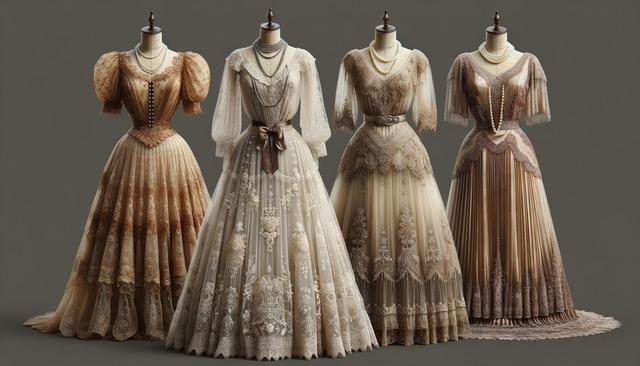The Enduring Appeal of Vintage Fashion
Elegant vintage dresses have a way of capturing the imagination like few other styles. Their timeless silhouettes and intricate details exude character, often telling stories from decades past. Whether it’s the cinched waists of the 1950s or the flowing lines of the 1970s, each era offers its own distinctive charm. These garments are more than just clothing—they’re pieces of history that reflect cultural shifts, artistic movements, and design ingenuity.
What makes vintage fashion so appealing is its uniqueness. In a world of fast fashion, vintage pieces stand out for their quality craftsmanship and rarity. Dresses from earlier decades were often handmade or produced in smaller quantities, with careful attention to detail. Owning one means embracing individuality and style with a touch of nostalgia. For many, wearing vintage feels like stepping into a story, one woven with elegance and personality.
How to Identify a True Vintage Dress
When searching for authentic vintage dresses, there are several indicators that can help distinguish genuine pieces from reproductions. One of the most telling signs is the label. Many vintage garments feature tags with names and logos that no longer exist or have changed significantly over time. Another clue lies in the garment’s construction. Older dresses often include features like:
- Metal zippers (as opposed to plastic ones)
- Hand-stitched seams
- Union labels or tags indicating country of manufacture
Fabric can also be a reliable indicator. Vintage materials like rayon, silk, and wool were commonly used and often have a heavier, more substantial feel than contemporary synthetics. It’s also helpful to familiarize yourself with the fashion trends of different decades to better understand what styles align with each era. This knowledge can make the process of finding authentic pieces both fun and rewarding.
Styling Vintage Dresses for Modern Wear
While vintage dresses are inherently stylish, integrating them into a modern wardrobe can make for a fresh and unique look. The key is in combining old with new in a way that feels effortless. For example:
- Pair a 1940s tea dress with contemporary ankle boots and a leather jacket
- Layer a 1960s mod shift dress with modern accessories like statement earrings or a crossbody bag
- Style a 1970s maxi dress with a denim jacket for a casual daytime look
By mixing eras and updating accessories, you can create a balanced outfit that honors the vintage garment without appearing costume-like. This approach allows you to enjoy the elegance of vintage while maintaining a current, wearable aesthetic. It also encourages creativity, making each ensemble uniquely your own.
Where to Find Elegant Vintage Dresses
Locating quality vintage dresses requires a bit of hunting, but the search can be as enjoyable as the find. Brick-and-mortar vintage shops often offer curated selections, and knowledgeable staff can help with sizing and authenticity. Thrift stores and flea markets may yield hidden gems, though they require more patience and a keen eye. Online platforms have also become a popular avenue for vintage shopping, with specialized retailers and marketplaces providing a wide range of styles from different decades.
When shopping online, it’s important to check measurements carefully, as sizing standards have changed over the years. Look for sellers who provide detailed descriptions, multiple photos, and return policies. Some helpful tips include:
- Using search filters for specific eras or styles
- Reading customer reviews for insights on quality and fit
- Reaching out to sellers with questions about the garment’s condition or origin
With time and attention, you can build a collection of elegant vintage dresses that not only enhance your wardrobe but also carry a sense of history and craftsmanship.
Caring for Your Vintage Collection
Once you’ve acquired a few vintage pieces, proper care is crucial to preserving their beauty and structural integrity. Vintage fabrics can be delicate, especially if they’ve been stored for years. Always start by checking the garment for any signs of wear or weakness, such as fraying seams or fading. When in doubt, consult a professional cleaner with experience in vintage textiles.
Some general care tips include:
- Hand washing or dry cleaning delicate fabrics
- Storing dresses in breathable garment bags
- Keeping them away from direct sunlight to prevent fading
Using padded hangers and avoiding overcrowding in the closet can also help maintain the shape of your dresses. If a piece requires repair, consider seeking a tailor familiar with vintage construction techniques. These small efforts can significantly extend the life of your garments, allowing you to enjoy them for years to come.
Conclusion: Embrace the Vintage Elegance
For anyone drawn to fashion with character and history, elegant vintage dresses offer an inspiring alternative to mass-produced trends. Their timeless appeal, craftsmanship, and individuality make them a meaningful addition to any wardrobe. Whether you’re a seasoned collector or new to vintage fashion, exploring these garments can open the door to a more thoughtful and expressive style. Embrace the elegance of the past—it just might become your signature look.






